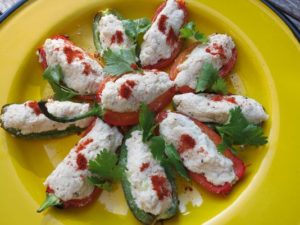Spice up barbecue with hot peppers
By Julie Falsetti, For The York Dispatch

Char and stuff hot peppers with tuna for a barbecue appetizer. The heat from the peppers varies, so no two will be exactly the same.(Photo: Julie Falsetti photo)
In 1912, Wilbur Scoville developed a scale to measure the pungency of chili peppers. Using the Scoville scale, you can now prove to your brother-in-law that the peppers you eat are hotter than the ones he eats.
In the pepper continuum, jalapeños are pretty low on the scale, with a range of 2,500 to 8,000 Scoville units. Compare that with the Bhut Jolokia, or ghost pepper, with a rating of 800,000 to 1,001,300 units, 125 times hotter than the jalapeño.
Of course, everything is relative. One person’s mild pepper might send another running for the water pitcher. As an aside, drinking water is not a good idea to cool off your mouth. The oil in peppers is not water soluble, so you would be better off having a sip of milk or beer, or better yet a spoonful of ice cream.
Having harvested an abundance of peppers from my garden, with a bit of trepidation, I brought a small batch of tuna stuffed jalapeños to a potluck picnic.
As a trial, I offered one to a friend who likes chilies. He popped it in his mouth and pronounced it “not hot at all.”
I relaxed and put the plate of stuffed peppers on the table for the rest of the guests. A few minutes later, the same friend came running over fanning his mouth. He got a hot one.
Because the Scoville scale gives a range for hotness, there can be quite a variation in how much capsicum each pepper contains. Whether from the supermarket or your garden, you never know exactly how hot the pepper is going to be. Some gardeners say “the hotter the summer, the hotter the pepper.”
If you want an alternative to cheese-stuffed poppers, give these tuna stuffed jalapeños a try. They make a great appetizer at barbecues.
Tuna-Stuffed Jalapeños
5 jalapeño peppers
1 5-ounce can tuna
1 heaping tablespoon mayonnaise
1 scallion, finely chopped
Dash of lemon juice
Salt and pepper to taste
Paprika for decoration
Using tongs, char the peppers over a grill or the gas flame of your stove. Immediately place the charred peppers in a brown bag and twist to close. Let rest for 15 minutes.
In the meantime, mix the tuna with the mayonnaise and scallion. Add salt, pepper and lemon juice and set aside. The tuna mixture will be a bit drier than tuna salad.
Take the peppers from the bag and peel them under cold running water, rubbing off the blackened skin. Slice the peppers in half lengthwise. Remove the seeds and ribs and rinse again. Allow the peppers to drain, then soak up any remaining moisture with a paper towel.
Fill the peppers with the tuna mixture and decorate with paprika.
— Julie Falsetti, a York native, comes from a long line of good cooks. Her column, From Scratch, runs twice monthly in The York Dispatch food section.
